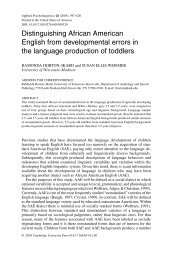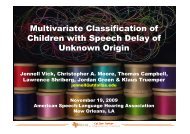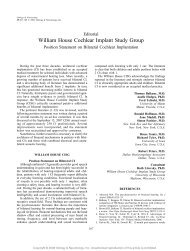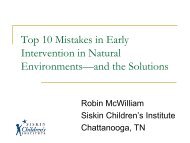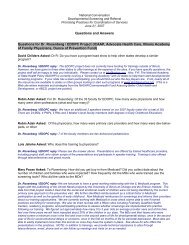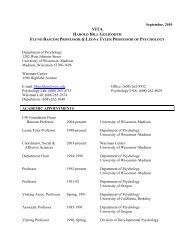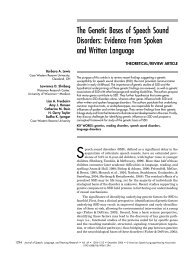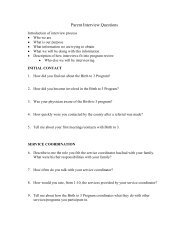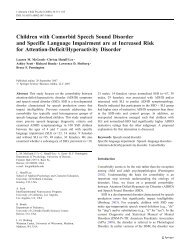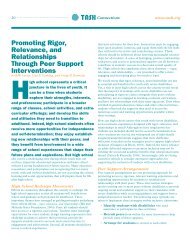Music and Language: A Developmental Comparison - Waisman ...
Music and Language: A Developmental Comparison - Waisman ...
Music and Language: A Developmental Comparison - Waisman ...
Create successful ePaper yourself
Turn your PDF publications into a flip-book with our unique Google optimized e-Paper software.
Learning <strong>Music</strong> <strong>and</strong> <strong>Language</strong>297exposed 12-month-old infants to a finite-state artificial grammar, presentedin sets of fluent sentences, where the only cues to word boundaries werestatistical. Infants were then tested with novel sentences that were eithergrammatical or ungrammatical. Importantly, the first-order transitionalprobabilities between syllables were identical for both grammatical <strong>and</strong>ungrammatical sentences. Thus, in order to succeed at this task, infantsfirst had to segment the words in the new language <strong>and</strong> then learn thepermissible orderings of these words. Nevertheless, infants showed a preferencefor grammatical over ungrammatical sentences, indicating that multilevelstatistical learning is possible in a short time frame. These results aremirrored by evidence that infants are aware of some of the aspects of thegrammatical structure of their native language early in the second year oflife (e.g., Hirsh-Pasek & Golinkoff, 1996).Our knowledge about how infants <strong>and</strong> young children learn the grammarof their native musical system is more limited, but available data indicatethat development of this knowledge is slower, emerging somewhatlater in ontogeny. We know that experienced listeners have a hierarchicalinternal representation of relevant structures within their musical idiomthat govern expectations of what is to come next (for a review, seeKrumhansl, 1990). Using a probe methodology in which subjects are askedwhich of a set of stimuli best completes a given context, Western listenerspreferentially end pieces on the tonic, less frequently on other notes in thetonic chord, still less frequently on other notes within the scale, <strong>and</strong> rarelyon notes outside the diatonic context (Krumhansl, 1990). No evidence hasyet been provided that infants use similar information in responding tomusical stimuli (though see Saffran, 2003b for preliminary evidence that 8-month-old infants treat tonal <strong>and</strong> atonal materials differently). However,by 5 years of age, Western children show some knowledge of Western tonalstructure (Trehub et al., 1986), <strong>and</strong> by 7 years this knowledge is comparableto an adult’s (Speer & Meeks, 1988). The reason for the slower paceof this type of grammar acquisition is unclear. Two possibilities are that (1)infants are exposed to fewer examples of musical phrases than linguisticones (which seems likely, though this has not been shown quantitatively),<strong>and</strong> (2) the practical communicative benefits of knowledge about tonalstructure are fewer than the benefits of structural linguistic knowledge.Advances in neuroscientific techniques have contributed to our underst<strong>and</strong>ingof syntactic processing in both domains (for a recent review ofthese techniques, see Tervaniemi & van Zuijen, 1999). Usingelectroencephalography (EEG), Osterhout <strong>and</strong> Holcomb (1992, 1993) foundthat words that are difficult to integrate into their surrounding sentenceselicit a positive brain potential 600 ms after their onset. This P600 component(also referred to as the syntactic positive shift, or SPS) appears to beinsensitive to other errors, such as semantically inappropriate word substi-



